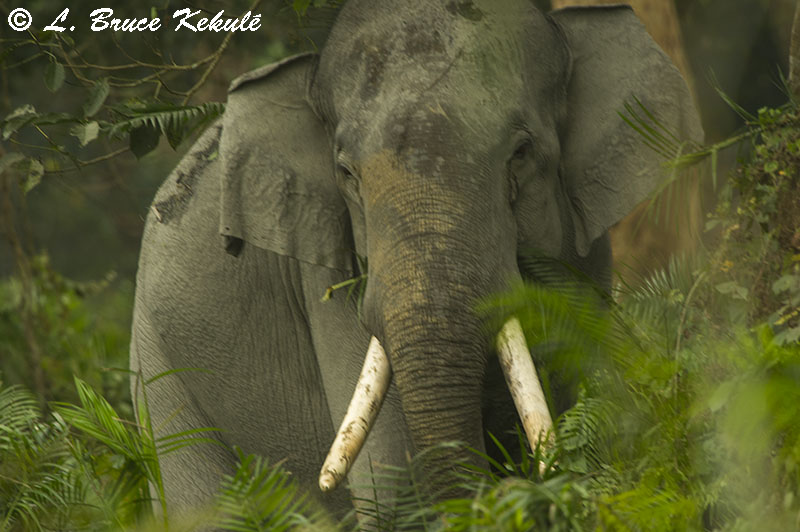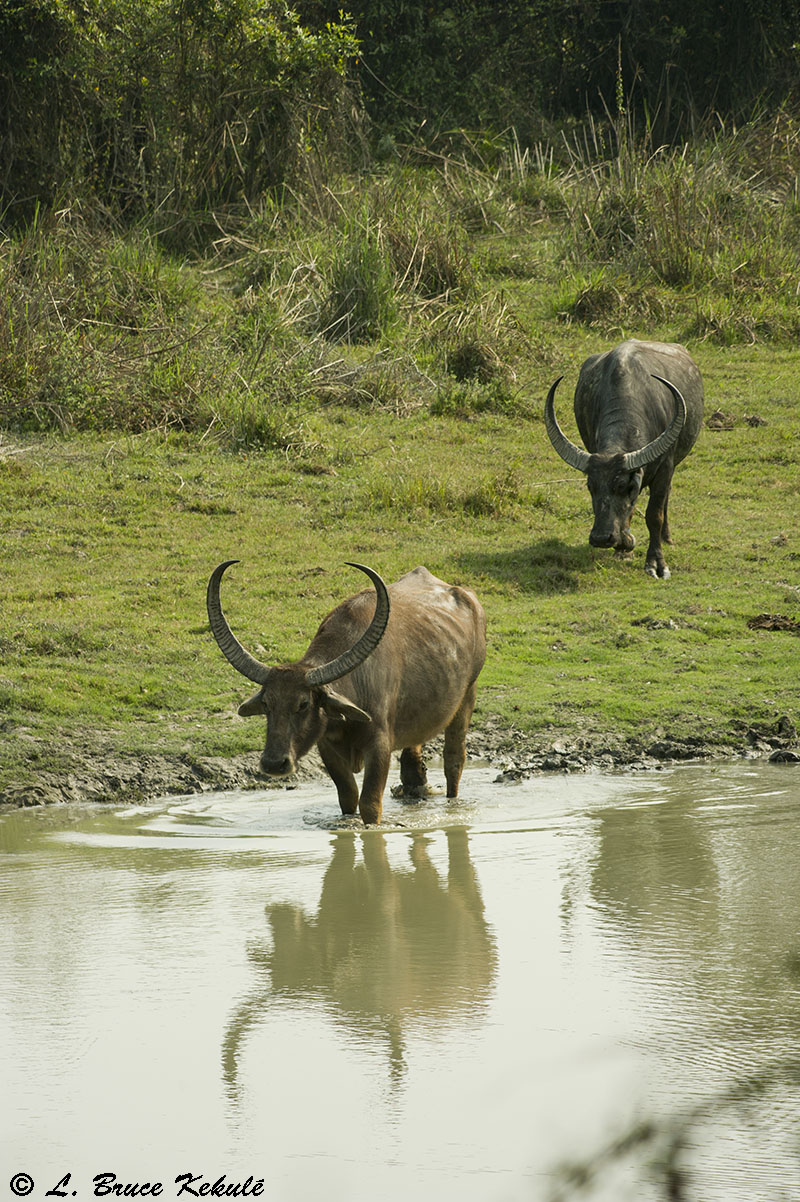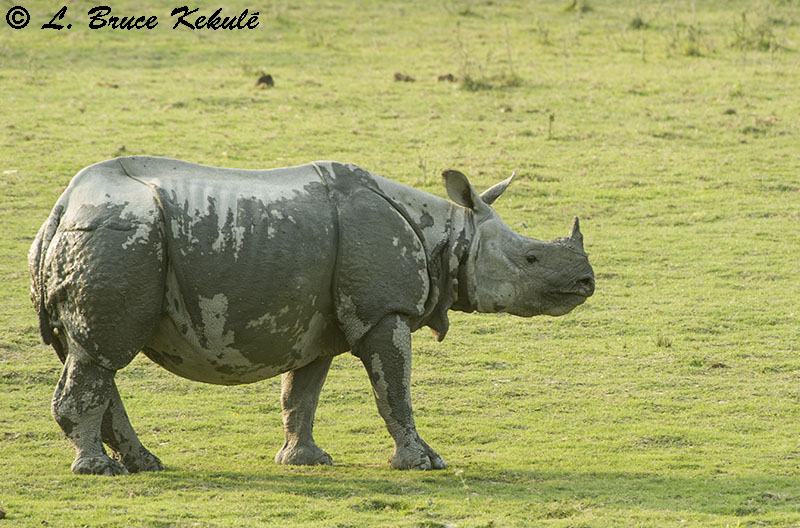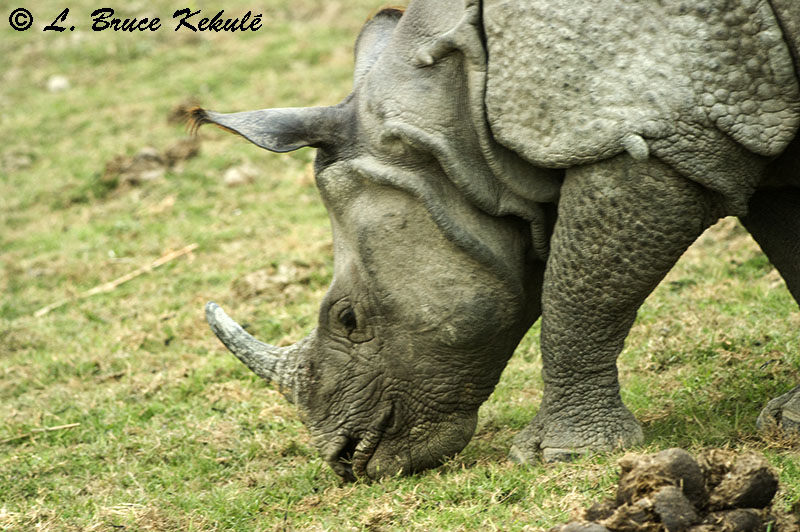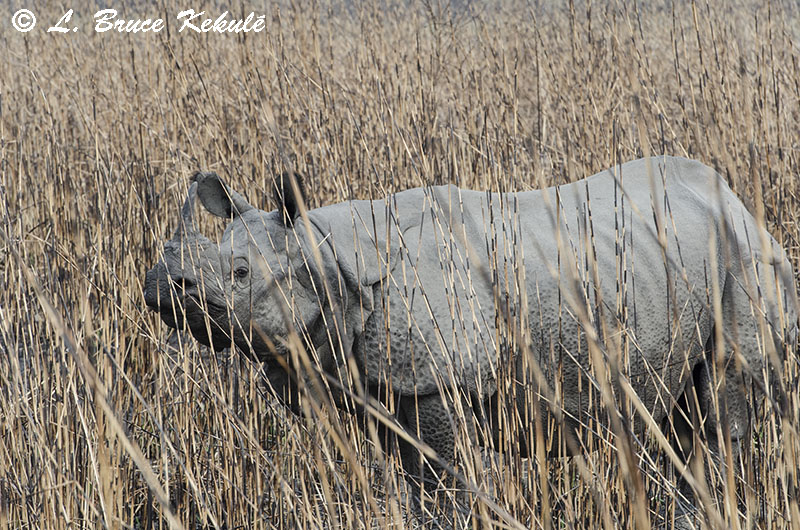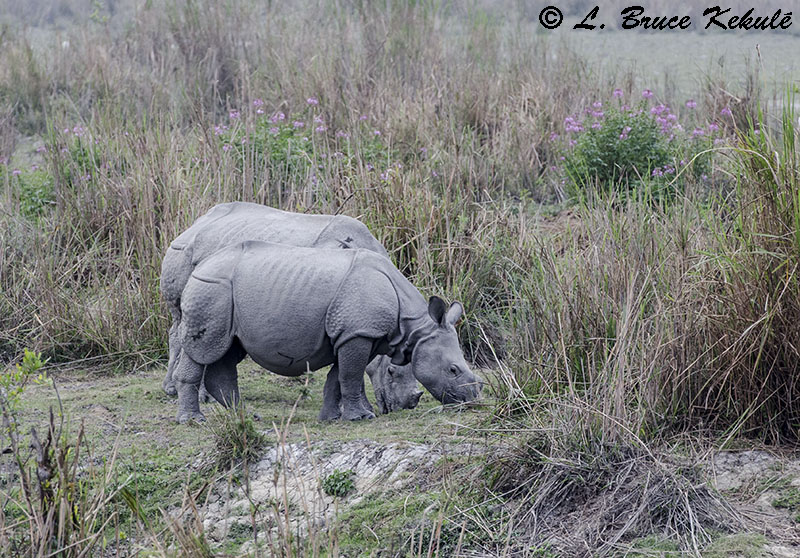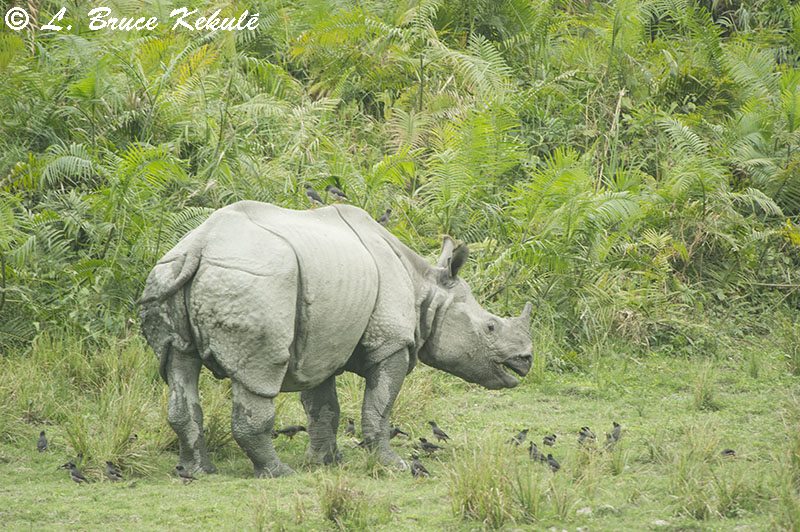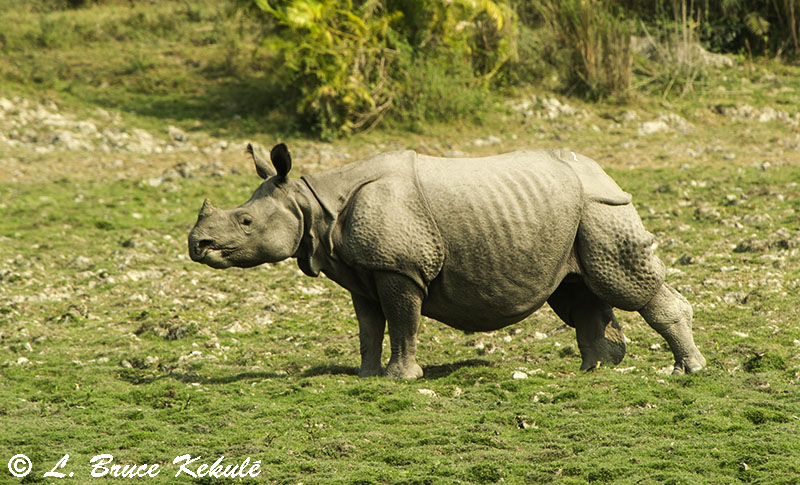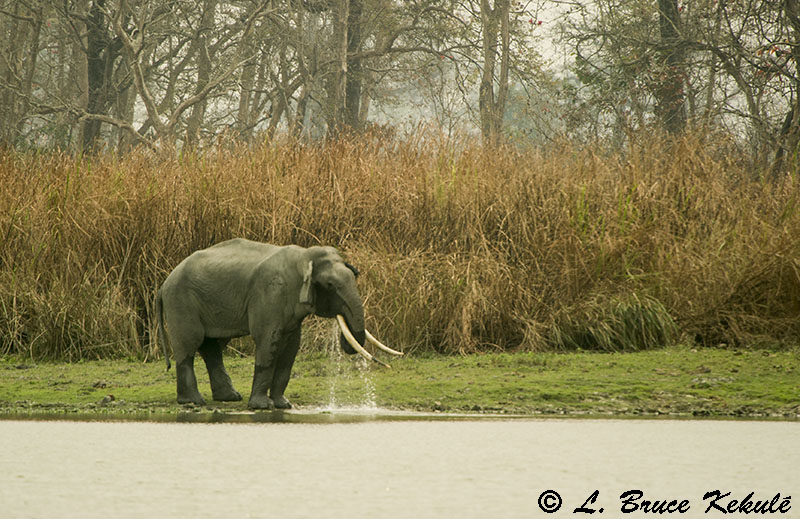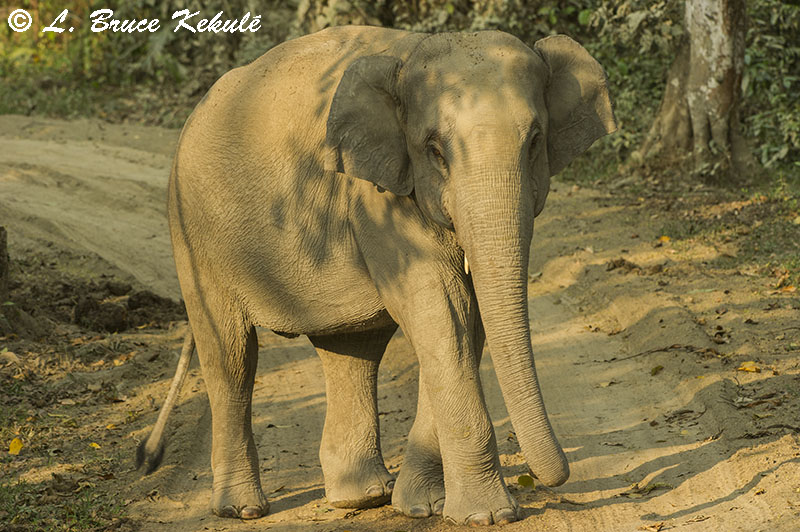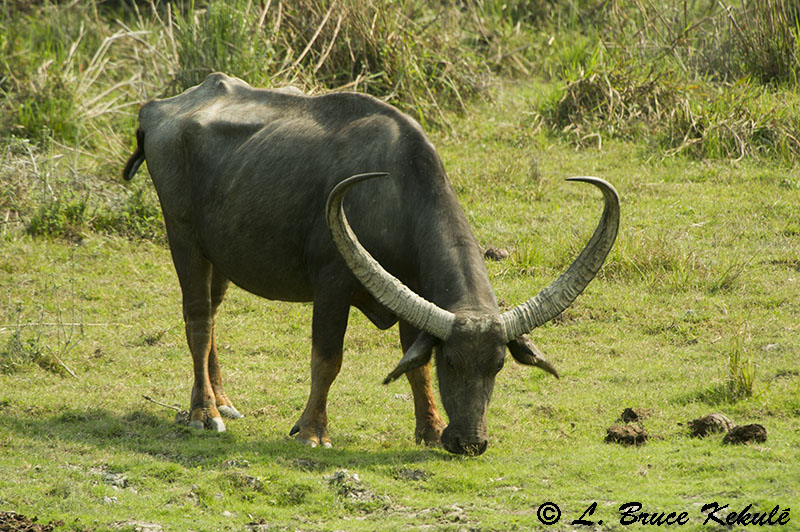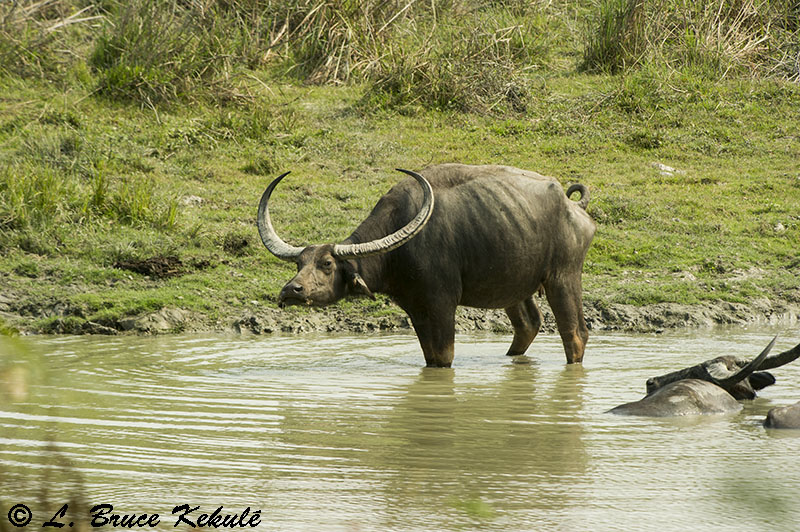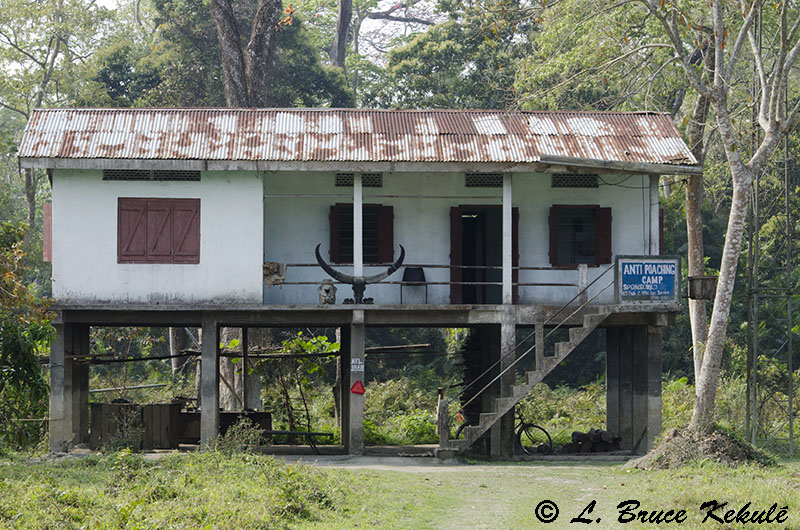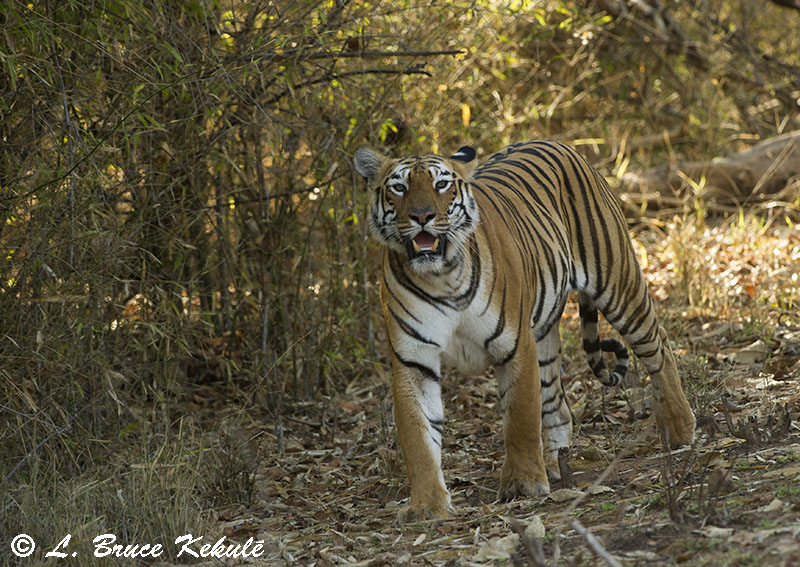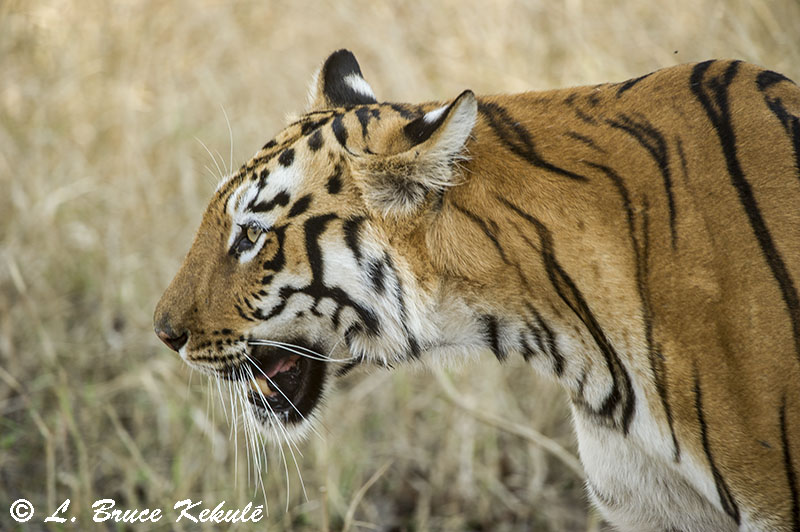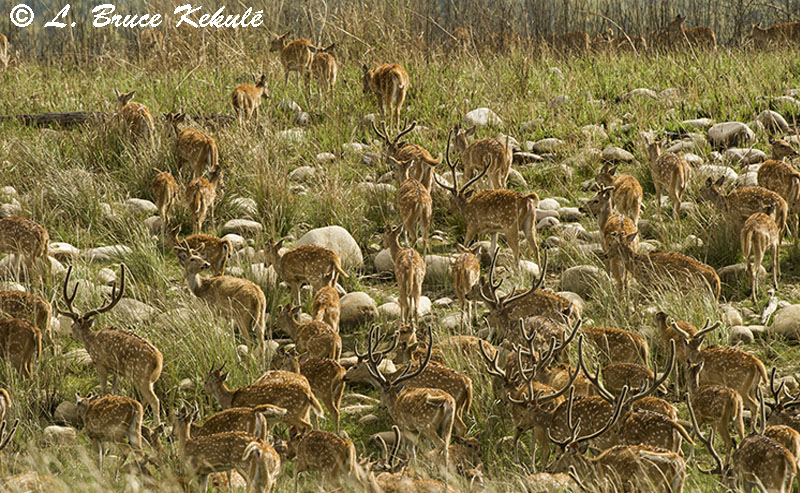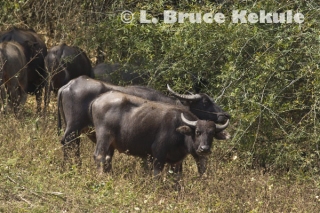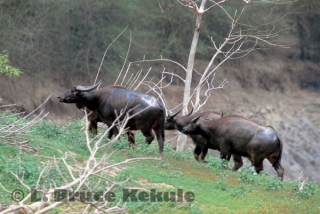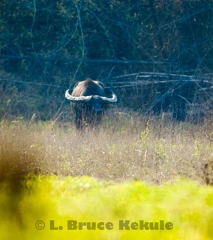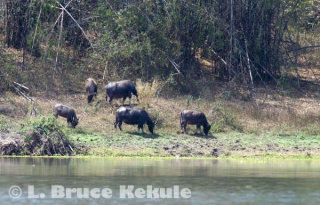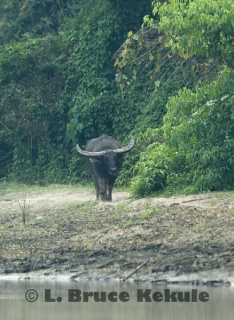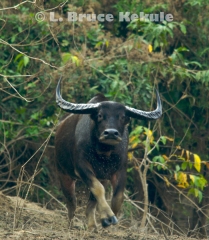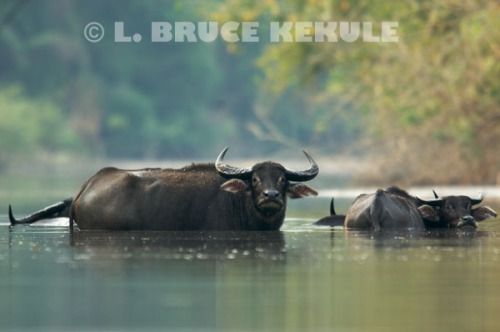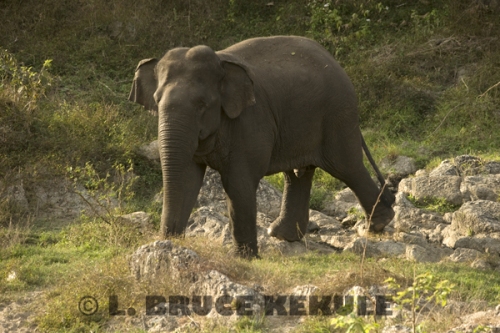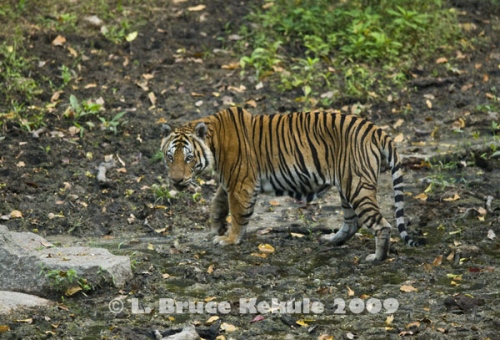Posts Tagged ‘Wild water buffalo’
Kaziranga National Park and Tiger Reserve: The greatest protected area in the world
From a dozen great one-horned rhinos to over 2,400 individuals in just 80 years…!
Kaziranga, a UNESCO World Heritage Site is situated in the State of Assam in northeast India, and encompasses some 430 square kilometers of grasslands, wetlands and river habitat plus a buffer zone amounting to another 400 square kilometers. Over time, the Assamese have created the greatest protected area in the world.
A close-up of a rhino bull and a mynah birds looking for insects at sunset. There are
some 2,400 rhinos in Kaziranga making this place absolutely amazing in regards to
these creatures still thriving in the wild, and where one can actually see them.
A big tusker with nice ivory. There are some 1,000 elephants in the park and they
have also flourished because of the pristine habitat, food sources and great protection.
But they are also targeted by poachers but on a much lesser scale. It’s easy to see
them in all areas of Kaziranga as they go about their daily lives.
A pair of wild water buffalo cows at a waterhole. Along with the rhino and elephants,
these bovid have increased to 1,300 individuals. The Indian sub-species have the largest
horns of any creature in the world, and Kaziranga has the highest density of buffalo.
In most places, the African and Asian rhinos are in trouble and close to extinction, especially the Javan and Sumatran species. Rhinocerotidae have been on earth since the ‘Late Eocene or Early Oligocene’ (about 33 to 28.3 million years ago). Being odd-toed ungulates and herbivorous, they thrive in these grassland and wetlands that are supplied nutrients from the annual floods from the great Brahmaputra River.
This river flows from the Himalayas through the park in the northern section. This waterway is one of India’s main lifelines providing water to millions of people downstream along its entire length all the way to Bangladesh emptying into the Bay of Bengal. Annual floods bring nutrients to the land and the ecosystem is replenished.
Originally established as a reserve forest in 1908, Kaziranga was declared a sanctuary in 1916 to counter extensive poaching of the rhinoceros. In 1974, the Indian Government demarcated the present area as a national park. Then, in 2007, it was declared a tiger reserve under the Central Government’s ‘Project Tiger’ scheme.
Rhino gallery: Over four days, I photographed loads of these prehistoric looking
creatures in all three zones (West, Central and East)…! It was simply amazing…!
Eighty years ago, the rhino population was decimated to just a dozen or so beasts by poaching for their horn in demand by the Chinese and Vietnamese. The Assamese government decided to really put its foot down and instigated a policy to eradicate poachers using ‘extreme measures’ throughout the park, plus increasing the ranger force by several hundred percent.
The animal population immediately began to pick-up, and the last senses in 2014 estimated that some 2,400 rhino, 1,300 wild water buffalo and 1,000 elephant are thriving in this small park. Along with this, there are over 100 tigers that live here too and the park has one of the highest densities of the striped cat per square kilometer in the world. As a destination to see these majestic and iconic creatures, Kaziranga is the place to go.
Wild elephant gallery: I saw these herbivores every day and in all zones. There are over
1,000 of these giants in the park…!
The Assamese people are very proud of their heritage and the park is a ‘case study’ on how to actually save a species from extinction. All the large mammals propagate in safety and show the world; if you look after a place with a mandate to rid the protected area of poachers, animals will flourish. However, it turned into a small war and many people were actually killed including some rangers.
Even so in 2014, about 50 rhinos lost their horns and poachers killed three tigers. The battle continues and the government has done a brilliant job of saving nature with a tough mandate of ‘shoot to kill’ in order to protect this place.
It has worked so well that it is now possible to see rhino everyday, and just about everywhere, even outside the park. As I was leaving for the airport after four days on a recent safari in Feb. 2015, there were some cars parked by the side of the road and photographers had their cameras out taking images of a rhino a hundred meters from the tarmac.
Wild water buffalo gallery: There are more than 1,300 of these bovid and I saw them
everyday in all zones…! They have the largest horns in the animal kingdom….!
There are three zones (West, Central and East) that tourists are allowed to enter and it is scheduled by the lodge where you are staying on what areas one can visit. The Big Three (rhino, buffalo and elephants) can be seen in all areas. If you are lucky, a tiger may appear at any time. There are many bird species thriving and it is a bird watcher’s paradise.
The Park is home to more than 70 percent of the one-horned rhinoceros left in the world and harbors more than 60 percent of India’s wild water buffalo population along with the only population of Eastern swamp deer (or barasinga). Other important wildlife found are: gaur, leopard, fishing cat, large and small Indian civet, sambar, barking deer, hog deer, hog badger, Hoolock gibbon, capped langur, Assamese macaque, rhesus macaque, sloth bear, Gangetic dolphin and otter, etc.
A fresh tiger pug mark on the road in Kaziranga. I did not see a tiger here but got
a wonderful shot of a running tiger in the grassland of Corbett National Park
in northern India….!
From New Delhi, the flight to Guwhati in Assam takes about two hours and then it’s another four hours by taxi to the Infinity Lodge where I stayed situated close to the three Kaziranga park gates. There are many other hotels and lodges and one can find these on the Internet. There is also a bus service that passes the park. Traffic to the park is a bit hectic at certain times since it’s the main road in the northeast India to the next state of Nagaland, and on into Myanmar. It has been said that smugglers use this route for tiger bones and rhino horn to China.
Some of the rare birds thriving in Kaziranga: A female black stork identified by a
yellow iris near a waterhole; a Kalij pheasant in the forest; two bar-headed geese
in the wetlands, and a grey heron and pelican swimming in a pond….!
One thing for sure: the Forest Department here in Assam is one tough cookie. They have increased rangers to 700 men and women, and have 162 guard posts with 3-4 rangers living in each of these quarters. They do mainly foot patrols and are always armed with a least a rifle (mainly British .303s but some men have newer generation .315 Indian rifles that is lighter in weight than the old cumbersome English service arm) or sometimes 12 gauge shotguns. Some of the elite forest guards have assault rifles. While on any safari in Kaziranga, a forest guard with a rifle is mandatory in case of an emergency. The men do mostly foot patrols around their respective areas.
Kaziranga gallery: The park has seen some serious flooding and the most extreme levels
have been recorded shown here at a ranger station. Travel and viewing wildlife is normally
done in Maruti (Suzuki) type jeeps. Controlled burning of the grasslands carried out by the
Forest Department benefits the herbivores when new grass sprouts up….!
Needless to say, it is perfectly safe to travel in and around the park. An armed forest guard to ride ‘shotgun’ is mandatory and is picked up at the gate. For the most part, you’ll be able to see these beasts in a Maruti (Suzuki) safari type jeep called a ‘gypsy’. It is the best way to view wildlife and there are many operators at most of the lodges. The forest department also offers guided tours on an elephant-back to get up-close to the big beasts.
The best time to visit Kaziranga is from November to April. I used a Company named ‘Wilderness Uncut’ (wildernessuncut.com) for all my arrangements. Wildlife photographers Anu Marwah from New Delhi, and Jason Fernandes from Mumbai are co-owners and they organized everything to perfection. Their service is top-notch and I know who will arrange any future trips to India for me. Being wildlife photographers, they know what is needed for a successful trip.
That’s me with my naturalist Polash Borah, driver Mohammed Nekib Ali and a forest
ranger at a rest stop station early one morning during my recent safari.
I also had the pleasure of working with Polash Borah, my naturalist (17 years of experience in Kaziranga) and Mohammed Nekib Ali (10 years experience) my driver who also acts as a naturalist. We spent four days together and had a great time. They know exactly what are the best areas for viewing and photographing wildlife, and both work at the Infinity Lodge just outside the park.
May 1st is ‘World Rhino Day’ in India, and Kaziranga National Park and Tiger Reserve is the best place in the world to see these rare creatures up-close. If you are planning on visiting a protected area first hand and want to view Mother Nature’s giants, make arrangements to Assam; you won’t be disappointed…!
Travel Info:
From Thailand, one of the best airlines to travel to India is ‘Air India’ that has a daily flight leaving Bangkok around 8am and arriving in New Delhi at noon. Arriving in the daytime in Delhi is much better and safer than arriving after midnight like some of the other airlines do. A connecting flight on Indigo Airways to Guwhati in Assam is very good and takes about two hours. They are a budget airline and have several flights a day. I recommend these two carriers as being very reliable and reasonable in price. Give yourself at least three hours through the New Delhi domestic airport, as it is extremely busy and crowded. Finally, when flying a domestic airline, a maximum of 15 kilos for check-in baggage is the standard. Anything over that weight will be charged as excess.
India’s ‘Big Six’: Majestic creatures thriving on the sub-continent…!
A photographic tour in three national parks with some pretty amazing animals
A tigress on the run in the grassland at Dhikala, Corbett National Park in the northern State of Uttarakhand.
In 2014, I made a decision to visit India once again in search of the most iconic species still thriving in three protected areas in the northeast, central and northern parts of the country. Kaziranga, Tadoba and Corbett national parks and tiger reserves respectively, were chosen for their wildlife biodiversity with the tiger at the top of the list. I visited the three from February 22 through March 16, 2015.
A mature bull elephant with some impressive ivory in Kaziranga National Park.
I wanted to photograph the big six: elephant, rhino, gaur, wild water buffalo, leopard and the tiger. I was extremely lucky encountering all of these amazing animals during this trip. This has definitely left a huge impression on me and is etched in memory. India’s wildlife and protected areas are some of the best places in the world to see Mother Nature’s wonderful creatures.
Male One Horned Indian rhino 10 minutes from the front gate on my first day in Kaziranga National Park.
A century ago, India was teeming with wildlife. There were some 40,000 tigers found here but that number quickly dropped primarily due to habitat loss after World War II when the population really began to surge and forest areas were overcome, and turned into agriculture fields and estates. Hunting on a grand scale was also responsible for the disappearance of the tiger.
Wild water buffalo cow in Kaziranga National Park.
In 2011, there were only about 1,706 tigers left but in 2014 after better methodology and camera trapping, that number increased to 2,226 individuals found throughout the continent. As a result of mass awareness and conservation measures, the tiger population has rebounded showing a remarkable growth of 30% in the past three years. But some scientists believe this number to be inflated and put the amount of tigers around the 2,000 mark.
A bull gaur with an extremely long tongue in Tadoba National Park.
On 22nd of February 2015, I boarded Air India for the 4-hour flight from Bangkok to New Delhi arriving at noon. After a quick hair-raising taxi ride through the city, I got to the hotel spending one night to rest-up in order to catch the next morning’s flight to Gauhati, the largest city in the State of Assam in northeast India. The hustle and bustle through the domestic airport in Delhi is very tight on security as it should be. But once through the x-ray machines, a bit of a breather and a coffee is welcome. You must get there at least three hours early because of the amount of flights leaving, and the thousands of people trying to catch their respective connections.
A female leopard during late morning in Tadoba National Park.
Kaziranga National Park: State of Assam
A young bull elephant in Kaziranga National Park.
I wanted to visit Kaziranga National Park with the objective of finding out why this place is the number one protected area in the world, and my top priority was the Great Indian one-horned rhino, and then on my list was the wild water buffalo, elephant and tiger in that order. I got the big three but the tiger remained elusive.
A water buffalo photographed by my friend Polash Borah.
My newly acquired friends, Polash Borah and Mohammed Nekib Ali, my naturalist and driver respectively were a big help in locating these large mammals. I let Polash use my Nikon D7000 with a brand new Nikon 70-200mm VRII lens, and he got a really nice buffalo shot posted here. I also managed to get some good photographs myself. It was a great trip and I met some very nice people.
A young one-horned rhino up-close. He was a curious fellow wanting to know who we were.
I will be going back to Kaziranga maybe in November of this year when the skies are clear blue and the air is crisp wanting to get some nice scenic shots especially of the wide Brahmaputra River that runs through the park from the Himalayas in the background, and the lush swamps and grasslands after the monsoon rains.
A mature wild water buffalo bull near a waterway in Kaziranga National Park.
Probably the most important fact concerning Kaziranga is that some 80 years ago, there were about 12 rhinos left here. The Government of Assam decided to do something and implemented some serious laws with a ‘shoot-to-kill’ policy on all poachers and illegal squatters, plus an increase of several hundred personnel. At last count, there are 700 rangers and 161 ranger stations to look after a small 430 square kilometer core area, and a 400 square kilometer buffer zone. After a census last year, there are over 2,400 rhino, 1,500 wild water buffalo and 1,200 elephant. Over 120 tiger have been recorded here and prey species also number in the thousands. In my opinion, it is probably the best-protected area in the world…!
Tadoba National Park: State of Maharashtra
A tiger named ‘Maya’ in Tadoba National Park; she is the most famous tigress seen almost everyday.
After four days in Assam, I flew back to New Delhi for a two-day rest and then boarded a flight on March 3 in the morning down to Nagpur further south. Then a two-hour taxi ride was needed to Tadoba National Park and tiger reserve in the State of Maharashtra. Arriving at the lodge in mid-afternoon, a needed rest and some lunch was in order. I did not go out on safari that afternoon because the park is closed on this day.
‘Maya’ up-close as she walked the road marking her territory.
The next morning’s safari netted a beautiful female leopard highlighted by some wonderful back-light. My spirits were up a hundred percent after photographing the spotted cat.
Female leopard jumping in front of our jeep.
Female leopard up-close as she checks her surroundings.
The next morning as we were rolling around the dusty roads, we bumped into a big crowd of jeeps but they were at the far-end of a one-way road. We waited and saw a tiger walk out of the forest near the jeeps but melted back in. The group then moved close to us but the tiger stayed in the forest. My driver Lahu from the Tiger Trails Lodge has been driving for the owner of the lodge for some 35 years, and knew exactly where the big cat would come out. And as sure as the sun comes up everyday, she popped out and walked right in front of us.
‘Maya’, the female tiger queen in Tadoba National Park: This was my last sighting of this beautiful cat.
I did not stop shooting as Maya, (probably the most popular tigress in Tadoba at the moment) walked along the road spraying and marking her territory. My new friend Dr Sundran Rajendra was with me, and the both of us were so elated that we just kept on shooting our cameras. Then time was up and we had to leave the beautiful cat to herself. It was Sundran’s first tiger and he managed to get some very nice shots of the big cat. She came so close I could almost touch her.
Another tigress, named ‘Choti Tara’ fitted with a radio collar snarls at my friend Dharmendra Sharma.
My other friend and naturalist with the lodge Dharmendra Sharma, was in another jeep so I let him use my Nikon D7000 and the new Nikon 70-200mm VR II, and he got some very nice photos of another female named ‘Choti Tara’ fitted with a radio collar. He also got a few nice shots of Maya.
Male tiger named ‘Gabbar’ fitted with a ‘radio collar’ in pretty bad shape.
On my last afternoon safari in Tadoba, I bumped into ‘Gabbar’, a male tiger also fitted with a collar. He got swatted by another male and was in pretty bad shape. But the wheels are in motion to fix him up. I just hope that the squeaky Indian bureaucracy does not wait too long to help this tiger, as he could turn into a cattle killer or even worse, a man-eater. Needless to say, news on Facebook is that he did kill a village buffalo but is OK for the moment, and is being monitored. After four days, I was back on the plane to New Delhi for a two-day rest before heading north to India’s first national park.
Corbett National Park: State of Uttarakhand
A young tigress stalking a herd of spotted deer in the grassland of Corbett National Park.
It takes about four to five hours north of Delhi by taxi through some very congested and dangerous traffic in the State of Uttar Pradesh to get to Ramnagar, a city in the State of Uttarakhand where Corbett National Park, India’s first national Park. It is situated in the foothills of the great Himalayas. I spent the first night at the Forest Department’s lodge at Bijrani, and went on safari that afternoon and then again the next morning.
A golden jackal on the run near the Forest Department’s lodge at Bijrani.
I did not see a tiger but the big cats were around as other jeeps that I bumped into got some nice close-up photos taken with an iPhone. An occupant in one of the vehicles gave me a telephone slide show. I did see a pair of golden jackals early in the morning and then later a small family unit of elephants. One old cow did a mock charge and came within 15 meters but stopped short and turned around going back to her calf. The elephants then faded off into the forest.
Elephants near the Forest Department lodge at Bijrani.
Around 12-noon, we left this section and went over to the Forest Lodge at Dhikala that is the best site in Corbett to see tigers. Near the lodge, there is a grassland savannah that attracts herbivores like spotted deer in great numbers, and of course many tigers come looking for prey. It is said the park has some 200 tigers, one of the highest densities in India.
A herd of more than 100 spotted deer; the prime food source for tigers in Corbett National Park.
On the second morning, we bumped into a young hunting tigress stalking a herd of over a hundred deer. Me, my naturalist Devendra Singh Neui and my driver Rasheed Ali, were the only ones at this location as all the other jeeps from the lodge (about 10 of them) were waiting for tigers by the forest road. She tried several times unsuccessfully to chase down a deer but the herbivores were on to her. I managed to get some really great images in the process.
The tigress on the run after spotted deer not far from the Forest Department’s lodge at Dhikala.
Later in the afternoon, the camp was abuzz with the news that a tiger was in the lower grassland, and after lunch, they all headed that way and waited nearby. When she appeared, the group went wild chasing after her but they all came up short. We hung back and this very smart tiger circled around to avoid them. I saw her one more time slinking in the grass as the light was fading but time was up as I snapped a few last frames. I had a great time here and have vowed to return to this remarkable place…!
The unlucky tiger chasers in the grassland of Dhikala, Corbett National Park.
The trip to Corbett was scheduled on very short notice by my agents Anu Marwah in New Delhi, and Jason Fernandes in Mumbai both wildlife photographers of great standing in India. They are joint owners of Wilderness Uncut (wildernessuncut.com), a company set-up to cater to wildlife photographers, naturalists and bird watchers. Their superb management and arrangements are first class with absolutely no hiccups and they are reasonable priced. It was a great, enjoyable and memorable trip for me. I can honestly say that I need look no further for anyone to help me with any of my up-coming trips to India.
The female tiger in the grassland of Corbett: this was my last sighting of this beautiful tigress.
One point that I must make here! You never get tired of seeing the world’s biggest cat and is one of the greatest predators that ever walked the face of the Earth. My thoughts are always with these felines and their future survival. Unfortunately, the future for the tiger looks dim, as the situation concerning the Asian medicine trade using their bones seems to be getting worse with more and more stories on the net and in the papers about this draconian belief. The biggest culprits are China, Vietnam, Laos and Thailand (Chinese in Thailand) that perpetuate this market. The tiger needs the whole world to stand up to these people and this illicit trade must be stamped out soon but it carries on with impunity. Until action is taken with economic sanctions and other means against the countries involved, this illegal black-market will continue to take the wild tiger into the dark depths of extinction.
Chasing a Wild Dream
A video about Thailand’s Amazing Wildlife in the Western Forest Complex. From wild elephants to green peafowl, this film shows the world the wildlife in the Kingdom’s protected areas, and the need to save this wonderful natural heritage for present and future generations to come.
In the heart of Southeast Asia, the Kingdom is blessed with some of the best and last remaining examples of Asian animals and ecosystems that harbor the tiger, leopard, elephant, gaur, banteng, wild water buffalo, tapir, sambar, muntjac, gibbon, green peafowl, hornbill, plus thousands of other amazing creatures and biospheres that have evolved over millions of years and show-case Mother Nature and her magnificent beauty…!
Wild Water Buffalo – Part Two
WILD SPECIES REPORT: The last wild herd in Thailand
Massive beasts with a mean temperament
Wild water buffalo calf by the river
Probably, the most significant species in Huai Kha Khaeng is the wild water buffalo (Bubalus bubalis). Due to a very small population with only about 50-60 individuals surviving, the future of these remarkable creatures in Thailand is uncertain. Many perils threaten them, such as foot and mouth disease, which could easily be passed on by domesticated buffalo living just outside the southern boundary of the sanctuary. Poaching and encroachment are also serious concerns.
Mother buffalo fully alert to any danger
I once photographed a female (with a rope through her nose) and a few of her calves mingling with a wild herd in the sanctuary not far from the southern boundary. I made a report to the authorities, and these domestic buffalo were separated from the wild herd and quickly chased out by the rangers.
Domestic buffalo mingling with the wild herd
It is a fact though; some local villagers have deliberately mingled their buffalo with the wild buffalo so the offspring would be sturdy. This is a very dangerous situation, which if not checked, may lead to the total demise of all the ungulates like deer, pigs and wild cattle in Huai Kha Khaeng. It may sound drastic, but that could happen one day. Cattle disease has no boundaries.
The southern border at Krueng Krai ranger station still remains a gateway for danger and must be protected at all costs. However, enforcement is difficult due to low budgets and just a few rangers to look after a very large area. This needs a serious revamp. The Department of National Parks (DNP) has increased security here but some locals seem intent on slipping through.
Wild water buffalo herd
Stricter laws are needed as a deterrent, and increased budgets and personnel implemented so this wonderful place is properly looked after. Anyone caught in the interior with firearms and evidence of poaching should do a long prison term. Unfortunately, with the present laws and possibility of corruption, law-breakers usually get off light and become repeat offenders.
Over the years, I have seen these magnificent buffalo on numerous occasions. During the late 1990s’ while I was still shooting film and working in Huai Kha Khaeng at the southern area, I managed to get some good shots of a herd wallowing in the river. But it was not the first or the last time I would bump into wild water buffalo.
Wild water buffalo herd
In 2006 armed with a new Konica-Minolta D7 digital camera and 600mm lens, I bumped into two bulls right across from Krueng Krai ranger station. One was a very old bull with a huge set of horns, and the other a younger bull posed for the camera over the course of several days. I was using a boat-blind but had no power except a paddle, and getting around was a bit difficult. However, it was still very gratifying seeing these rare beasts and photographing them.
Late last year, I had a unique experience photographing a young male calf and its mother. Green peafowl and otters are plentiful but my main objective is always the same, photographing the buffalo. My last encounter was in March of this year. I again motored up-stream and bumped into two large bulls cooling off in the river. They were very shy and took off as soon as they saw me but not before I got a couple of good shots. Judging from their horns, these two were very mature bulls.
Very old wild water buffalo bull
At the beginning of the dry season, the river is very low but still deep enough to navigate up-stream using a new camouflaged kayak with pontoons on either side, and a silent trolling motor hooked up to a 12v truck battery for power and maximum maneuverability. Controlling the boat-blind is easy as I motor along using the electric motor and I can easily steer the craft with a rudder made of aluminum attached to the stern. I use three anchors (one fore and two aft) when I need to be steady in the water.
A Nikon 400mm f 2.8 lens and camera is firmly attached to the hull using aluminum tubing and braces plus a gimbal-styled tripod head suitable for a large telephoto. I sit comfortably behind the camera ready to shoot at a moments notice. This boat actually is very stable and has allowed some close encounters with large mammals. Camouflage material is draped over everything to blend in with the background.
Wild water buffalo herd
Over the years, quite a lot of research has been carried out on the buffalo in Huai Kha Khaeng. One of the first was Napparat Naksathit, the former chief of Khao Nang Ram Research station. He did an ecology and distribution survey of buffalo in 1984. Then Tanya Chan-art in 1986 and Wichan Ucharoensak in 1992, did consensus surveys to determine numbers. Dr Rattanawat Chaiyarat from Mahidol University did his thesis on the buffalo. Dr Terrapat Prayurasiddh, now the deputy director general of the Royal Forest Department, did an aerial survey using a helicopter, also to establish numbers. Around that time, the deputy chief of Huai Kha Khaeng, the late Pongsakorn Pattapong researched and photographed the buffalo. He was an avid photographer but passed away from too much exposure to chemicals while developing his own film. And finally, Manoch Yindee is currently working on wild buffalo genetics in the sanctuary, and domestic buffalo throughout the Kingdom.
A mature buffalo bull can weigh up to a ton with hooves more than 20cm (8 inches) across. They leave deep tracks in the sandy soil by the river. These magnificent bovids are much larger and more aggressive than their domestic counterparts. Wild buffalo have a distinct forehead with horn bases closer together than domestic buffalo, whose boss is wider apart.
Wild buffalo have a fierce temperament and if provoked, can be very dangerous to man. A herd will group together to face a predator like a tiger or Asian wild dog. Male solitary bulls charge without hesitation. Many a hunter has had a close call or been killed by these massive low-slung beasts. A bull will gore and then toss the intruder before stomping on the victim with its huge hooves. They are extremely determined and will sometimes continue to attack until the enemy perishes.
The author in an old boat-blind
Buffalo live in herds with one mature bull looking after the females. During the breeding season in October-November, the herd bull will fight other solitary bulls. Females have one calf, and gestation is about 10 months. A buffalo’s daily ritual is a visit to the river to drink and cool off. They will wallow to coat their hides with mud protecting it from biting insects.
This is the last wild herd in Thailand and, in Southeast Asia for that matter. India and Nepal have some large herds, and Cambodia may have a few individuals but they could be feral. Centuries ago, wild water buffalo were found in alluvial lowland plains and rivers throughout the Kingdom. As most waterways have been overcome by humanity, domestication of the wild buffalo was only a matter of time. It is said wild buffalo were domesticated before 2000 BC. Fossil evidence of buffalo from the Pleistocene Epoch has been uncovered in many sand deposits along the Chao Phraya River.
Antlers of a Schomburgk’s stag
The DNP is responsible for Huai Kha Khaeng and its management, and they should make protection and enforcement around the southern area a top priority. With only one location for wild water buffalo left in the Kingdom, total security is required so these magnificent creatures will be around for future generations to appreciate. It is hoped they will not end up like so many other animals that have gone extinct such as the Schomburgk’s deer and the Kouprey, and that would be a sad day indeed.
Trophy horns of a Kouprey bull
Wild Water Buffalo – Part One
WILD SPECIES REPORT: The last wild herd in Thailand
Massive beasts with a mean temperament
Young buffalo bull locked onto my boat-blind
Coincidence, according to the dictionary, is the occurrence of two events at the same time. I guess the following story would be seen by most as just that. However, I personally believe that good things come our way after we have made merit.
Such was the case when I showed up with a bag of rice at Huai Mae Dee, a ranger station in Huai Kha Khaeng Wildlife Sanctuary in March of 2007. My longtime friend and chief of the station at the time, Khun Fern, accepted the rice, saying we would cook it in the morning and make an offering to some monks. I agreed and retired for the evening in my comfortable hammock. The weather was cool and I slept well after the long drive from Bangkok.
Up at six, the food was prepared and we both eagerly waited. After a short while, the holy man arrived with some of his followers. We filled their alms bowls with rice and curry. I gave a Thai version of my second book Thailand’s Natural Heritage to the abbot of the temple, hoping it would help the local people around to understand more about Mother Nature. Feeling good at having made merit, I packed up and headed south to where the wild water buffalo live.
Old buffalo bull by the river
After more then three hours of grueling off-road driving, a forest ranger and I set-up camp by the lower Huai Kha Khaeng about mid-day. We had lunch and put my boat-blind together. I then motored upriver for several hours. On the way, I observed some smooth-coated otters hunting along the shoreline but these carnivores quickly disappeared after seeing the boat.
About 4pm as I rounded a bend, a small group of wild water buffalo cooling off in the river actually surprised me and I hesitated for a few seconds locked-on to the herd. About the same moment, I heard a national parks helicopter in the distance out on patrol and it was headed my way so I quickly gunned the electric trolling motor to get closer to the herbivores not thinking there was any danger.
When I was about 50 meters away, I started shooting my camera knowing the helicopter would certainly spook the buffalo. Nonetheless, I noticed a young bull in the herd staring directly at me. He moved up the shoreline followed by a larger cow and the rest of the herd galloping towards the boat-blind. I just kept firing away until my heart shuddered – as I finally realized I was being charged. I suddenly made a gut-wrenching effort to motor the boat out of harm’s way, just as the noisy helicopter hovered overhead. After a few seconds, I looked back and the buffalo were gone.
Buffalo cow charging my boat-blind
Had I been saved by the arrival of the mechanical flying bird – or was it the spirits of the forest that caused such a coincidence and protected me? I will never know how close I came to an attack by the aggressive buffalo, but these photographs are some of the most exciting I have taken as a wildlife photographer. A month later, I photographed a herd of wild elephants in the river not far from the same site. There were a few tense moments with baby elephants in the family unit. My camouflaged boat-blind has definitely paid for itself.
The most gratifying thing was seeing these rare beasts and catching them on digital. There are only 50 individuals surviving in the sanctuary and they can be tough to see and photograph. But it was not the first or the last time I would bump into wild water buffalo. During the late 1990s’ while I was still shooting film and working in Huai Kha Khaeng at the southern area, I managed to get some good shots of a herd wallowing in the river.
Buffalo bull, a purple heron and several pond herons



